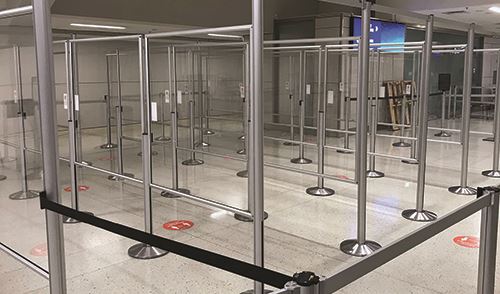When COVID-19 first began lashing the United States last winter, Dallas Fort Worth International Airport (DFW) initiated a multimillion-dollar response effort within weeks. As early as January 2020, the airport increased its cleaning/disinfecting frequency and rolled out strategies and procedures specifically designed to address the emerging global health crisis.
When COVID-19 first began lashing the United States last winter, Dallas Fort Worth International Airport (DFW) initiated a multimillion-dollar response effort within weeks. As early as January 2020, the airport increased its cleaning/disinfecting frequency and rolled out strategies and procedures specifically designed to address the emerging global health crisis. New tools it is leveraging include high-tech sanitizing equipment for frequently touched surfaces, ultraviolet light technology to clean the air and an updated queuing strategy to encourage social distancing at TSA checkpoints, ticketing counters and other line-prone areas.
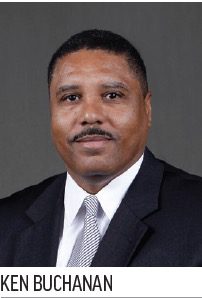 Ken Buchanan, the airport’s executive vice president of Revenue Management and Customer Experience, explains that DFW’s commitment to safety and security has always been a top priority. And, as traffic volumes were plummeting throughout the industry due to the pandemic, DFW’s top focus became finding a proactive and targeted response to meet the new needs of the traveling public. “We made the decision to enhance our cleaning and sanitization efforts and reinforce the customer experience,” says Buchanan.
Ken Buchanan, the airport’s executive vice president of Revenue Management and Customer Experience, explains that DFW’s commitment to safety and security has always been a top priority. And, as traffic volumes were plummeting throughout the industry due to the pandemic, DFW’s top focus became finding a proactive and targeted response to meet the new needs of the traveling public. “We made the decision to enhance our cleaning and sanitization efforts and reinforce the customer experience,” says Buchanan.
Toward that end, the management team created a multidisciplinary group called the Readiness Task Force. It’s comprised of employees focused on customer service as well as personnel from support departments such as procurement, risk management, human resources and public safety. Together, task force members analyzed and enhanced safety measures in an effort to rebuild customer confidence in air travel. They also worked closely with public health agencies at federal, state and local levels.
DFW’s Innovation Team reviewed emerging coronavirus safety practices from across the world to identify new tools that could be used in its facilities. As a result, the airport established a 165-member cleaning strike team that supplements traditional custodial staff in cleaning high-touch areas more often. It also invested in Clorox® Total 360 and Victory electrostatic sprayers to sanitize frequently touched surfaces such as door handles, elevator buttons, holdroom seating, etc., and ultraviolet technology to kill airborne germs.
Buchanan notes that the effort to overhaul cleaning and sanitization procedures was not easy, even with strong collaboration and widespread support from airport partners. “There were many difficulties along the way, especially at our airport, which has the potential to see upwards of 100,000 customers a day,” he remarks. “We noticed that just when an intensive cleaning process was completed, it was time to start it all over again.” There were also hurdles in finding innovative and effective solutions without losing sight of the real mission, the need to make this transformation under a truncated timeline.
But the goal of maintaining a safe, secure environment for travelers and airport workers kept the response teams resolute. In the end, their efforts yielded results that garnered recognition from multiple organizations, including the Global Biorisk Advisory Council (GBAC). In fact, DFW became the first airport in the world to earn GBAC STAR Accreditation for stringent disinfection techniques and rigorous practices to combat biohazards and infectious disease. Its concessionaires and lounge operators earned the certification, too.
“The cross-functional team’s work in earning the GBAC certification demonstrates to the public that DFW is a safe airport to travel through, starting at the curb, to the airport lounges and concessions,” summarizes Buchanan.
Even with this new feather in its cap, DFW continued to make additional improvements.
Tech Tools
As restroom maintenance took on even more importance than usual, management felt the need to track cleaning progress throughout the day. So the airport hired TRAX Analytics to provide real-time data about supply usage and maintenance metrics in all 156 restrooms throughout its five terminals and a new terminal currently under construction. In essence, DFW wanted to take the smart technology it had already installed to the next level.
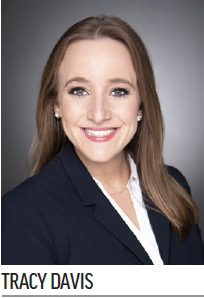
“We had the tools available to monitor the soap dispensers, paper towels, toilet paper usage, throughput and stall occupancy for every restroom where the technology was utilized,” says Tracy Davis, president and chief executive officer of TRAX.
The next step for DFW, now underway, is training teams of custodians to log details on iPads about when they arrive at each restroom and how long they spend cleaning it. Additionally, display screens outside restrooms will inform customers when crews are cleaning and guide them to the nearest available restrooms.
“Through the use of this cutting-edge technology, we not only support cleaning efforts but also the optics associated with them,” Davis says. “These tools help support a cleaner and safer environment and give confidence back to customers that we’re taking this seriously.”
She notes that TRAX has many customizable tools and technology options that can be installed in just two weeks. The project at DFW, which added nearly 5,000 sensors, took four months and cost about $3 million.
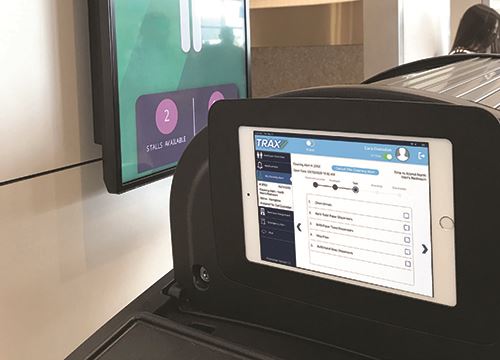
Another tech-oriented initiative spearheaded by the Innovation Team involved modifications to the airport’s heating, venting and air-conditioning systems. Responding to research indicating that short-wave ultraviolet light (UV-C) is effective at eliminating airborne COVID-19 germs, DFW became one of the first airports worldwide to embrace the technology. Incorporating the Manhattan Construction Group of Dallas’s UV-C technology into four terminals and the Rental Car Center cost $5.4 million.
“We didn’t put a dollar value on the lengths we would go to for safety at DFW,” Buchanan remarks. “We would provide this high standard for our customers in this new environment with COVID no matter the amount.”
Passengers Return
With many of the changes fully implemented and more in the works, DFW was ready for passengers to return to its facilities. When states loosened travel restrictions and COVID fatigue set in among the public, some travelers were eager to hit the skies once again.
In June 2020, DFW rocketed to No. 1 in passenger volume and temporarily became the world’s busiest airport. However, as passenger volume increased, so did lines at security checkpoints. This prompted the airport to consult an existing supplier, Lavi Industries, for guidance about keeping customers properly distanced. The company, which already had stanchions in place at DFW’s 15 security checkpoints, updated queuing plans to help keep travelers safe at checkpoints that were configured before COVID-19 was a consideration.
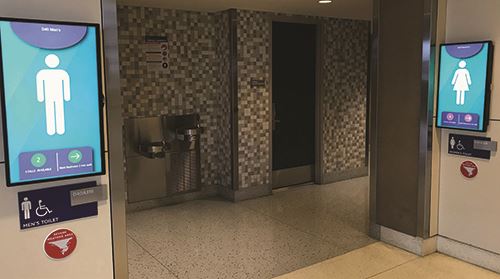
“We developed a comprehensive airport solution for when people started traveling and waiting in line at the security checkpoint and in other areas,” says Jonathan Jennings, Southwest account executive for Lavi Industries.
The company tapped into its own 40-year history and worked with airport management, engineers, the local fire department, TSA and others to revamp the strategy for managing lines and ushering passengers through the airport. Modifications included installing acrylic panels to minimize germ spread while passengers wait in lines, adding signage about COVID prevention and broadcasting safety messages within the intra-airport train system.
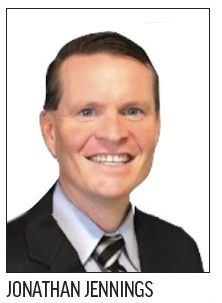
“We demonstrated that the Lavi product worked well in this COVID-19 environment, and we were able to use as much of the equipment already on hand at DFW to keep them within budget,” Jennings notes.
Initial conversations about revising queue strategies began in June 2020, followed by several walking tours of the facilities by Lavi and airport personnel. By early November 2020, COVID-specific queue strategies, 600 acrylic guards and other new components were in place at all 15 TSA checkpoints.
“Every airport has unique configurations and needs,” says Jennings. “We know no one wants to spend money in the middle of a pandemic, but we work within perimeters and budgets to provide an affordable and great product.”
A New Standard
Quick response from DFW, its contractors and partners has been well received by the public. Buchanan reports that customer surveys indicate that travelers trust DFW’s decisions and new coronavirus protocols. The airport also earned high marks for facility cleanliness.
These two areas are not only important to customers, but to the DFW team as well. “We didn’t take these safety measures to just flaunt them,” says Buchanan. “The actions we’ve taken will be a way of life for us and will be the standard our customers expect now and in the future.”
Meanwhile, airport personnel continue to research and test new COVID-19 response measures.
|
Combating Coronavirus Dallas Fort Worth International Airport (DFW) is taking action on a number of fronts to prevent the spread of COVID-19. Measures it is using include:
|

